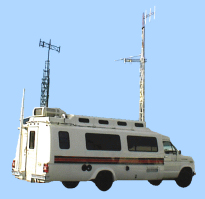NAB, Day 3 and there were many papers and presentations to suggest that the take up of the American digital radio system (called HDradio) is finally happening.
| Infiltrating the FM bands
Digital Radio in North America took a different route forward in the 1990s to the European direction. Instead of developing digital radio systems like DAB and DRM which 'stand alone' as digital systems, usually in a new frequency slot, the US 'IBOC' system is based on encircling an existing analogue FM signal with a digital version of the same programme. The IBOC receiver uses both.
For years it proved difficult to get IBOC (In Band On Channel) to work well, because the digital signal would interfere with the neighbouring FM signal. This problem was eventually solved by using more efficient digital audio compression. For some years the system then languished because of a lack of receivers. | Breaker, breaker ... |
A World Radio?
HDradio also has its sights set on use by the rest of the world, and the system has been tested, for example, in Switzerland. HDradio simply adds to an existing FM radio signal, so it does not need a new broadcast channel to be planned. In this sense it is a simpler system than European DAB, DMB, or DRM. But, equally, the system will always need its analogue FM base, because it is an integral part of its 'failure' characteristic. It can therefore never be switched off. It will perhaps be the only analogue broadcast that will need to remain indefinitely, and the maximum spectrum efficiency gains of digital broadcasting for radio will not be achieved.
Access services
Europeans, however, could learn from the steps HDradio is taking to serve the handicapped. There will be handicapped-friendly radios, speech-to-text conversion radios for cars, and various community services.

